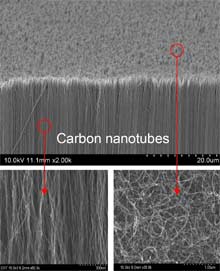Sticky Nanotape
For years, materials scientists have been trying to catch up with geckos. Adhesives that, like gecko feet, are dry, powerful, reusable, and self-cleaning could help robots climb walls or hold together electrical components, even in the harsh conditions of outer space. But it’s been difficult to design strong adhesives that can be lifted back up again. Now researchers have developed an adhesive made of carbon nanotubes whose structure closely mimics that of gecko feet. It’s 10 times more adhesive than the lizards’ feet and, like the natural adhesive, easy to lift back up. And it works on a variety of surfaces, including glass and sandpaper.

Developed by a group led by Liming Dai, a professor of materials engineering at the University of Dayton, and Zhong Wang, director of the Center for Nanostructure Characterization at Georgia Tech, the adhesive is not the first made from carbon nanotubes. However, it’s much stronger than previous nanotube adhesives. Its branched structure more closely mimics the structures on gecko feet, which are covered with millions of microscale hairs that branch into many smaller hairs, each of which has a weak electrical interaction with a surface. These many weak interactions add up to strong adhesion over the area of the foot. Previously, researchers have shown that arrays of vertically aligned carbon nanotubes have similar interactions with a surface.
“People have tried to mimic the gecko structures, but it’s not easy,” says Dai. Using a silicon substrate, he and his group grew arrays of vertically aligned carbon nanotubes topped with an unaligned layer of nanotubes, like rows of trees with branching tops. The adhesive force of these nanotube arrays is about 100 newtons per square centimeter–enough for a four-by-four-millimeter square of the material to hold up a 1,480-gram textbook. And its adhesive properties were the same when tested on very different surfaces, including glass plates, polymer films, and rough sandpaper.
One advantage of this adhesive over others is that its strength is strongly direction dependent. When it’s pulled in a direction parallel to its surface, it’s very strong. That’s because the branched nanotubes become aligned, says Dai. But when it’s pulled up with little force, as one would peel a piece of Scotch tape, the nanotubes lose contact one by one.
Multimedia
Watch the tape in action.
The greater the adhesive strength, the better, says Ali Dhinojwala, a professor of polymer science at the University of Akron. However, says Dhinojwala, who works on carbon-nanotube adhesives as well, “we also need to solve other problems before they’re commercially viable.” Wall-climbing robots will require adhesives that work again and again without wearing out or getting clogged with dirt. “We want a robot to take more than 50 steps in a dirty environment,” says Dhinojwala. No one has demonstrated strong gecko-inspired adhesives that can do this. And nanotube adhesives will need to be grown on different substrates than those used so far. Carbon nanotubes are easy to grow on silicon wafers; creating large areas of the adhesive wouldn’t be a problem. But “we’re not going to stick silicon wafers to robot feet,” says Dhinojwala.
Dai says that carbon nanotubes’ versatility may help overcome the dirt problem. These structures can readily be functionalized with proteins and other polymers. Dai is developing adhesive nanotube arrays coated with proteins that change their shape in response to temperature changes. A robot could have feet that heat up when they get clogged, shedding dirt so that it can keep walking.
Other applications of the adhesive may take better advantage of carbon nanotubes’ properties than robotics would. Carbon nanotubes are highly conductive to electricity and have promising thermal properties, Dai notes. Nanotube adhesives created to replace solder for holding together electronics components could also act as heat sinks. Other gecko-inspired adhesives made of polymers can’t hold up to high temperatures, says Metin Sitti, who heads the nanorobotics lab at Carnegie Mellon. Spacecraft using nanotube adhesives instead of polymers could go to hotter areas.
Keep Reading
Most Popular
Large language models can do jaw-dropping things. But nobody knows exactly why.
And that's a problem. Figuring it out is one of the biggest scientific puzzles of our time and a crucial step towards controlling more powerful future models.
The problem with plug-in hybrids? Their drivers.
Plug-in hybrids are often sold as a transition to EVs, but new data from Europe shows we’re still underestimating the emissions they produce.
Google DeepMind’s new generative model makes Super Mario–like games from scratch
Genie learns how to control games by watching hours and hours of video. It could help train next-gen robots too.
How scientists traced a mysterious covid case back to six toilets
When wastewater surveillance turns into a hunt for a single infected individual, the ethics get tricky.
Stay connected
Get the latest updates from
MIT Technology Review
Discover special offers, top stories, upcoming events, and more.